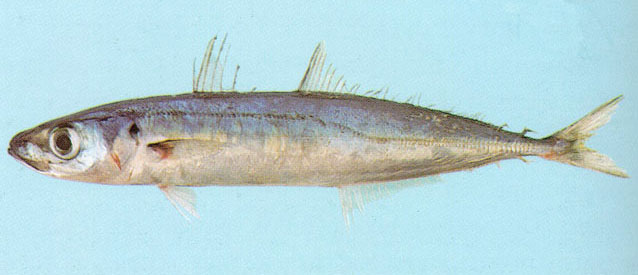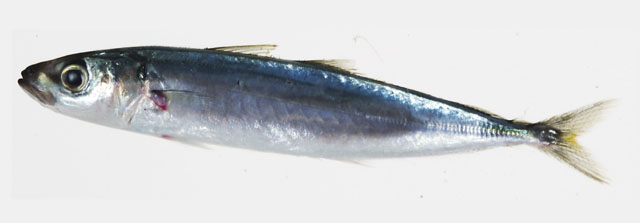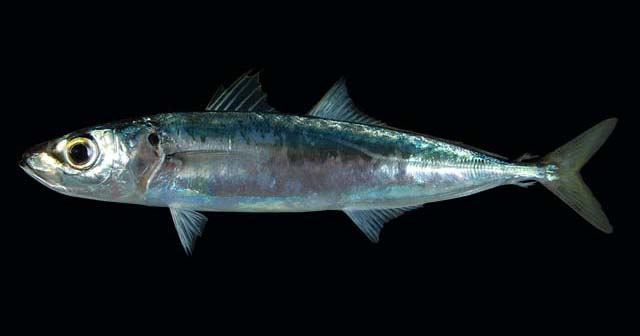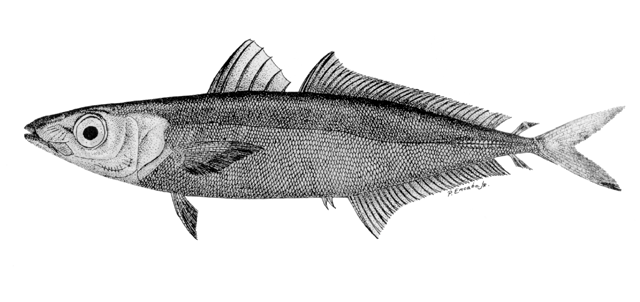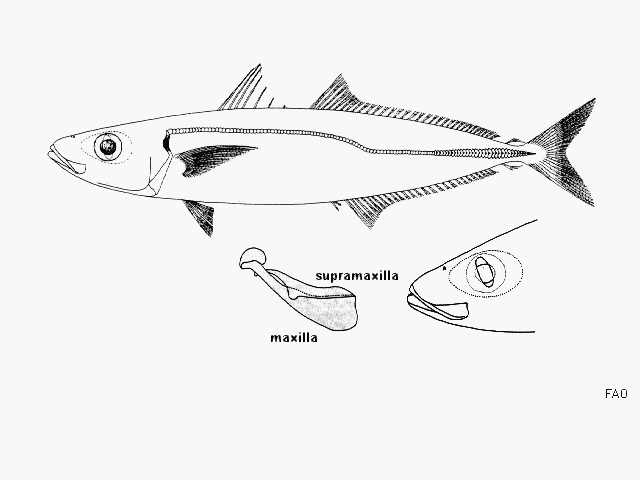Decapterus
macrosoma
Bleeker,
1851
Shortfin scad
View all media / Upload your photos and videos
Expand all
Classification / Names
Teleostei (teleosts) > Carangiformes (Jacks) >
Carangidae (Jacks and pompanos)
> Caranginae
Etymology: Decapterus: Greek, deka = ten + Greek, pteron = wing, fin (Ref. 45335).
More on author:
Bleeker.
Environment / milieu / depth range / climate zone / distribution range
Distribution
Indo-Pacific and Southeast Atlantic: from Knysna to Natal, South Africa to Australia, including Persian Gulf and the Red Sea, and in the Central Pacific Islands from South Korea to Gulf of California to Peru, including Galapagos Islands (Ref. 9283). Distribution in south Western Australia, and South Australia is false.
Maps

Decapterus macrosoma / Native range
AquaMaps Data sources:
GBIF
OBIS
This map was computer-generated and has not yet been reviewed.

Decapterus macrosoma / Suitable habitat
AquaMaps Data sources:
GBIF
OBIS
This map was computer-generated and has not yet been reviewed.

Decapterus macrosoma / Point map
AquaMaps Data sources:
GBIF
OBIS
This map was computer-generated and has not yet been reviewed.

Decapterus macrosoma / Year 2050
AquaMaps Data sources:
GBIF
OBIS
This map was computer-generated and has not yet been reviewed.
Length at first maturity / Size / Weight / Age
Short description
Dorsal spines (total): 9; Dorsal soft rays (total): 33 - 38; Anal spines: 3; Anal soft rays: 27 - 30. Body slender, elongate, and somewhat circular in cross section; posterior end of upper jaw concave dorsally and with a rounded protrusion ventrally; edge of shoulder girdle (cleithrum) with two small papillae, the lower one larger; dorsal and anal fin each followed by a separate finlet (Ref. 55763). Color metallic blue dorsally, silvery ventrally; fins hyaline; opercle with a small black spot (Ref. 2334). 24-40 scutes. Very slender compared to similar species (Ref. 48635).
Biology
Main reference
Paxton, J.R., D.F. Hoese, G.R. Allen and J.E. Hanley 1989 Pisces. Petromyzontidae to Carangidae. Zoological Catalogue of Australia, Vol. 7. Australian Government Publishing Service, Canberra, 665 p. (Ref. 7300)
IUCN Red List Status (Ref. 125652)
Least Concern (LC); date assessed: March 09 2015
CITES (Ref. 131153)
Not Evaluated
CMS (Ref. 116361)
Not Evaluated
Threat to humans
Harmless
More information
- Countries
- FAO areas
- Ecosystems
- Occurrences
- Introductions
- Stocks
- Ecology
- Diet
- Food items
- Food consumption
- Ration
- Common names
- Synonyms
- Metabolism
- Predators
- Ecotoxicology
- Reproduction
- Maturity
- Spawning
- Spawning aggregation
- Fecundity
- Eggs
- Egg development
- Age/Size
- Growth
- Length-weight
- Length-length
- Length-frequencies
- Morphometrics
- Morphology
- Larvae
- Larval dynamics
- Recruitment
- Abundance
- References
- Aquaculture
- Aquaculture profile
- Strains
- Genetics
- Allele frequencies
- Heritability
- Diseases
- Processing
- Mass conversion
- Vision
- Pictures
- Stamps, Coins Misc.
- Sounds
- Ciguatera
- Speed
- Swim. type
- Gill area
- Otoliths
- Brains
Estimates based on models
Preferred temperature (Ref. 123201): 22.1 - 28.6, mean 27.3 °C (based on 829 cells).
Phylogenetic diversity index (Ref. 82804): PD50 = 0.501 [Uniqueness, from 0.5 = low to 2.0 = high].
Bayesian length-weight: a=0.01000 (0.00852 - 0.01174), b=2.97 (2.94 - 3.00), in cm total length, based on LWR estimates for this species (Ref. 93245).
Trophic level (Ref. 69278): 3.4 ±0.5 se; Based on food items.
Generation time: 1.2 (1.1 - 1.3) years. Estimated as median ln(3)/K based on 47 growth studies.
Resilience (Ref. 120179): High, minimum population doubling time less than 15 months (K=0.50-1.60; Fec = 43,000).
Prior r = 1.11, 95% CL = 0.73 - 1.67, Based on 3 data-limited stock assessments.
Fishing vulnerability (Ref. 59153): Low vulnerability (16 of 100).
Price category (Ref. 80766): Medium; Questionable: based on ex-vessel price for species in this genus.
Nutrients (Ref. 124155): Calcium = 252 [86, 571] mg/100g; Iron = 2.71 [1.03, 5.61] mg/100g; Protein = 20.4 [19.1, 21.6] %; Omega3 = 0.221 [0.118, 0.405] g/100g; Selenium = 73.4 [27.8, 171.8] μg/100g; VitaminA = 48.8 [16.3, 163.0] μg/100g; Zinc = 1.31 [0.80, 2.07] mg/100g (wet weight); based on nutrient studies.

